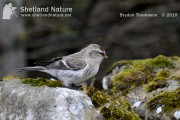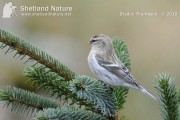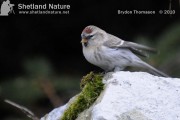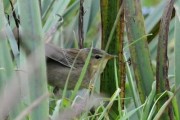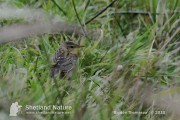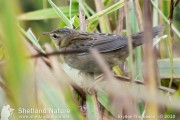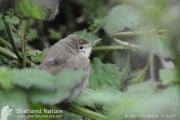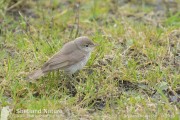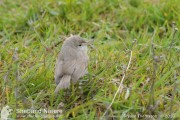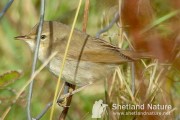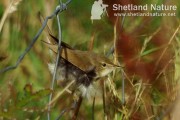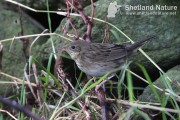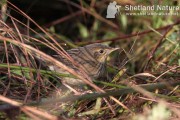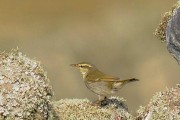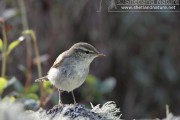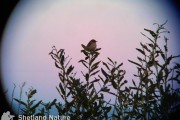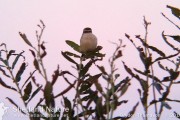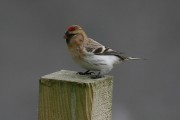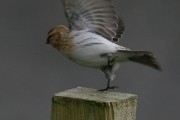Archive for the ‘Birding in Shetland’ Category:
Coues’s Arctic Redpoll
Posted by Brydon Thomason on Wednesday 13th October 2010 | Birding in Shetland
Redpolls are undoubtedly one the most complicated and difficult family groups of passerines facing birders in Europe (and beyond). Not only can their identification be problematic, whether in the field or even in the hand but for some subspecies and in some regions very little or in some cases nothing is known of their populations or indeed their distributions.
(We hope to put together a bit of a redpoll write up in a future posting when we will look at the redpolls we encounter in Shetland.)
Over the past decade or so in Shetland records of Arctic redpolls, which are split into two forms hornimanni and exsillipes have swung full circle. Coues’s Arctic Redpoll (exsillipes) is now not only very rare in Shetland but also in Britain. In the past ten years or so there have been as few as literally two or three claims of the species in Shetland. It has even been discussed as a possibility to be reinstated as a national rarity to be considered by BBRC.
With this in mind, when I came across this bird in Baltasound on Unst whilst taking a ‘birding drive around the block’ to get our 11 month old son down for his afternoon nap, I set about trying to confirm its ID- and hopefully with photos.
Thankfully the bird favoured a roadside verge in the lee of a plantation, which was right next to a lay-by where I could use the car as a mobile hide. It was at least ten years since I had seen one of these ‘fluffy forms’ of Arctic Redpoll. It’s very small and compact size and structure was instantly recognisable as being so very different to the hulking great Hornemann’s we are now so familiar with in a North isles autumn. As a gauge of size, very often Twite is the first and most appropriate to compare or indeed for Hornemann’s even House sparrow! This bird was certainly no larger than Twite, if anything it appeared possibly even a fraction smaller.
But eliminating its North Western Arctic originating counterpart was not a concern, more importantly and potentially more problematically was to rule out very pale Mealy or Icelandic Redpoll, the former having started to arrive in small numbers only days before. The arrival of Meallie’s from the North East was also in itself a good indicator that they should ‘be on the radar’.
Fortunately the bird was quite obliging and allowed me to obtain photographs, even if it was nearly dark! These are some of the features which I noted to be good for a Coues’s;
- Over all compact and small size and fluffy appearance (especially under parts -flanks, thigh area). Bill appeared distinctly petite especially when fore-crown was raised, thus creating that classic cute appearance.
- Lacked any warm or buffish tinges to ear coverts and face, instead rather cold and greyish with thin faint but quite dense streaking.
- Faint and pale buffish wash to sides of breast.
- Quite a broad clean and totally un-streaked white rump, but as is quite typical fairly well streaked on longest upper tail coverts.
- Broad and bold clean white wing bar with tertials and primaries being distinctly fringed with crisp, clean white fringing.
- Mantle evenly and distinctly streaked down centre, greyish and white with more diffuse and irregular to the sides. This along with the crisp white fringing created a very frosty overall appearance.
- The under parts were wholly very clean and snow white, but it did show faint grey and diffuse streaking all the way down flanks which were most defined on sides of breast area.
- The under tail- coverts appeared very clean and un-streaked but actually had a single short thin and defined streak on each of the longest two utc’s , which is well within the range.
If accepted this will be the first record in Shetland away from Fair Isle for about eight years. I have the feeling that this may well be the first of several this winter…
Permalink
Pallas’s Grasshopper Warbler- lord of the locustella’s
Posted by Brydon Thomason on Saturday 9th October 2010 | Birding in Shetland
Without question Pallas’s Grasshopper warbler is one of the most sought after of Siberian vagrants to reach Britain, or indeed Europe. For many determined ‘listers’ and seasoned rarity hunters it is a dream find. At last this year, my luck was in and my time had come!
Searching for rare locos in autumn is one of my main ornithological objectives and draws me to search the ditches, marshes, Irises and Canary- reed grass beds every year. This has indeed worked for me on more than one occasion for Lanceolated warbler but for the ‘lord of the locos’, AKA ‘PG Tips’, I had to be a little more patient before I would find my own.
Accompanied by James McCallum and with my 11 month old son, Casey, strapped to my back, we had almost finished working a lush network of Iris beds and Meadow sweet when out it came. Its first flight was a short one, silhouetted against the sunlight. Its long tailed appearance and largish size was enough to excite us both as we took a few steps towards where the bird came down.
As we cautiously closed in it took flight once again. This time its striking plumage tones were remarkably obvious. James and I looked at each other in disbelief. Its bright, yellowy-buffy olive toned underparts, very warm chestnuty, rufous toned rump contrasting distinctly with the longish and very dark tail, were already enough for us to know what was in front of us. “Why wasn’t that a Pallas’s Grasshopper Warbler?”, James rather gleefully and sarcastically asked, knowing full well, as I did, that it clearly was one.
The next few seconds were amongst the most surreal birding moments of my life. We edged excitedly closer, brimming with anticipation, to where it had landed along a well grazed fence line, determined to get ‘on the deck’ views without flushing it. Casey then decided to rather cheerfully remind me he was there! His happy but rather loud vocalisations (baby banter) had me thinking the bird was sure to fly. But at the same time I found the whole scenario completely bizarre and yet so very special to have him with me at such a momentous occasion. I glanced at James who I was pleased to see by his expression was amused by his antics.
Eventually I was in a position to see the bird crouching on the ground in full view – a pristine example of a first winter autumn PG tips – it was ‘in the bag’! I carefully side stepped away from the bird and out of view of it and gestured over to James (who was just out of view of where it sat) with a few celebratory punches into the air, “Get in – we’ve done it!!” Along with a couple of obligatory rare bird finding expletives of course.
But no matter how obvious the bird was to us there and then, we had to make sure to note all the key features and hopefully secure some photographs. With this in mind I speedily returned to the car to grab my camera.
As with acrocephalus warblers, locustellas can be very difficult, especially as their skulking nature can make it hard to assess key features in the field. Although it was never an issue with this bird, Grasshopper warbler has to be eliminated if you find an autumn loco and it’s a good starting point to assume that’s what a bird is most likely to be, rather than assume it to be rare because its Shetland as many people do! These are the main key features we noted to confirm its ID;
- Overall largish size and structure with longish rather heavy ended tail.
- Plumage was very contrasting looking overall.
- Underparts strikingly bright buffish olive toned, completely lacking any streaking especially on undertail coverts where cleanest.
- As mentioned above, very dark blackish rounded tail contrasting markedly with the warm chestnut-rusty toned rump then darkly and well defined streaks on warm toned mantle leaving a fairly plain nape.
- Crown distinctly dark-capped with well-defined clean yellowy-buff supercillium with a yellowy wash from face onto throat.
- The tertials (and primaries) were quite dark blackish as was the tail and were neatly and distinctly white tipped with each having a tiny crisp-white tip. The tail too showed neat restricted white tips. These two features being of course where it gets its nickname of P-G-Tips!
Away from Fair Isle (where it is something of a speciality with 21 records to date) there have been 14 in Shetland and just eight records from the rest of Britain.
Permalink
Sykes’s Warbler – Shetland’s third of the year
Posted by Brydon Thomason on Wednesday 6th October 2010 | Birding in Shetland
On the morning of the 6th October James McCallum (who had stayed the night with myself and family) headed out before me, leaving me to get our 11 month old son Casey ‘up and about’ for the morning. He had literally been gone two minutes when my mobile rang, “I’ve got a Booted or a Sykes’s in front of your parents’ house”. I could see him standing by our agricultural sheds, literally a stone’s throw from the kitchen window! Before I had even hung up the phone my bins, jacket and Muck boots were donned as I left my wife Vaila with our son.
At this point James had quite literally only had a couple of very brief views of the bird. Only days before he had alerted Roger Riddington (a fellow Shetland Nature leader) to check out the Channerwick ‘Booted’ as in his mind it appeared far from a typical Booted warbler. That bird was actually then re-identified by Roger as a Sykes’s warbler, despite having been present for several days and watched by many birders, including tour groups who all ‘ticked it off’ as a Booted.
Knowing this, and by the expression on James’s face as I joined him to relocate it, I had the feeling it was going to be a much rarer bird than Booted warbler…
It took a few minutes to relocate the bird. It was quite mobile at first, often dipping down amongst the lush docking leaves in the area it seemed to favour, where it found shelter from the strengthening breeze blowing from the south west.
During the course of our observations the bird eventually began to settle as it no doubt started to familiarise itself with its rather unfamiliar surroundings. Being in the fortunate position of us both having very recent experience of Sykes’s (for me Rory and Will’s bird in August) the identification was quite straight forward and eliminating other potential ‘hippo’s’ was not a concern.
Between us we set about evaluating the features the bird showed or indeed didn’t show. The following were among the main conclusive features;
- Structurally the bird’s long-billed and long-tailed appearance was immediately obvious.
- Its ‘jizz’ and posture were also good; typically Sykes’s hold a ‘banana’ shaped profile with the long tail held above the horizontal and the wings dropped either side (a stance also typical of Blyth’s reed). This profile is slightly exaggerated with the longish bill and long sloping fore-crown.
- The tertials were very pallid and plain, showing no contrast at all. Like Blyth’s reed warbler they were totally concolourous with the rest of the upperparts as opposed to the slightly contrasting centres shown in Booted warbler. The fringing of the flight feathers did however show slightly warmer and faintly richer tones at time. This feature (along with all the others noted) were also quite distinct on Rory and Will’s bird on Unst in August).
- The lores were completely unmarked and comparatively quite long (with the ’beedy’ eyes appearing to be set slightly back) which created a distinctly ‘open- faced’ and rather blank looking facial pattern and overall ‘soft’ expression. This impression was probably further exaggerated by the distinct, bold and well defined supercilium which stopped just above the eye, merging into a clean and quite distinct eye ring. The sub-coronal/lateral crown stripe (border above the ‘super’) was almost lacking and only at certain angles could you see a hint of one, unlike Booted which is often more pronounced.
- The bare parts too were important features, with the legs and feet being a fairly pale grey with a slight bluish tinge. Booted warbler having paler fleshy coloured legs with darker feet (hence the name ‘Booted warbler’).
- Like the Unst bird in August, this one often called, giving a soft, short, dry and rather acrocephalus like ‘chck’, distinctly different from that of a Booted warbler.
By the time the first birders arrived (amongst them our ‘Autumn birding’ tour group led by Martin Garner- their second Sykes’s of the week!) the Sykes’s had become very obliging, giving views down to a few metres.
Incredibly this bird represented the third Shetland and fourth British record of the year. Prior to this year’s birds there had been only a dozen records in Britain, half of which are from Shetland.
For me personally it was a real thrill being in on this bird, having found one on Unst back in 2003 (the 6th British record), it being a first for Fetlar and, most importantly, a garden tick for the list I still keep at my parents’ house!
Permalink
Blyth’s Reed Warbler
Posted by Brydon Thomason on Wednesday 6th October 2010 | Birding in Shetland
Our week long ‘Birdwatch’ magazine reader holiday couldn’t have been going better. Our first two days had seen us stacking up a fantastic cast of rarities such as Buff-bellied Pipit, Hornemann’s Arctic Redpoll and Buff-breasted Sandpiper to name but a few. Self finds for the group had already added a fruitful flavour and sense of team spirit in the form of two Little Buntings, Yellow-browed Warbler, Common Rosefinch and Richards Pipit.
The self- finding focus was set to continue when on the morning of the 3rd of October a superb sub-adult White-billed Diver was a brilliant discovery for the group from the Fetlar ferry. It was the finding of a particularly un-obliging acrocephalus warbler, later in the day, that would eventually prove to be ‘bird of the day’ (even if it was only confirmed three days later!).
Autumn ‘acro’s‘ can, and very often are notoriously difficult, especially when un-obliging. With just over half an hour before we had to leave for our ferry off we found an ‘acro’ that even from the first flight views looked very interesting. Time was however not the only factor acting against us, a rather strong southerly wind was freshening making an already elusive ‘acro’ even more determined to find cover.
Right from our first flight views it was obvious that this birds more dainty and compact structure, vary pale, olive and sandy tones and rather ‘fragile’ looking flight was very different to that of the Reed Warblers we had been seeing. To me these features were excitingly familiar and were very strong indicators for Blyth’s Reed Warbler and my co leader Martin Garner also shared my enthusiasm.
With experience these features can be surprisingly distinctive on Blyth’s Reed, as birders familiar with the species will know. Taking identification further is however often a much trickier matter as we found with this bird. Good and prolonged views or indeed photographs are a must to nail the ID. With barely fifteen minutes left before we had to leave, we had managed neither.
Only once distantly and for a fleeting second did we see the bird out in the open when it did seem to show strikingly clean white under parts and distinctly plain and pallid looking sandy and olive toned upper parts and a nice clean ‘super’- all pro BRW features. However without views good enough to accurately assess primary length or tertial detail, both crucial ‘acro’ ID features- we simply couldn’t do anything more with it, we hadn’t even confidently ruled out Marsh Warbler- all seemed lost for our ‘acro’…
A second chance
Three days later a number of visiting birders were on Fetlar for the Sykes’s, and some independently called or texted to report an acro at Aith (exactly the same place). They all favoured identification of the bird as Marsh Warbler. Our bird was still there- we had a second chance!
Accompanied by James McCallum I arrived back at the site. Once again the first flight views brought me right back to my very first impressions; “surely this has to be a Blyth’s Reed?” I asked myself. Glancing over the yard at James who I could see was thinking the very same, we moved in. Moments later the bird worked its way out of cover and out into the open, for the first time revealing itself and indeed the features we so wanted to study days before;
The overall plumage features we had first observed were confirmed- strikingly clean and silky white under parts contrasting slightly with the sandy-olive toned upper parts
The tertials looked plain showing very limited contrast (none at all from some angles and probably more visible on the photographs) and appearing rather con- colourous with rest of upper parts, primaries also lacked contrast with rest of wing (these features eliminate Marsh and Reed).
Primary projection looked relatively short – c70% of the tertial length
Also the super was clean and crisp and quite striking – and extended just marginally behind the eye. Unlike most Reed Warbler it was more obvious than the pale eye-ring
We both agreed-it was indeed a Blyth’s Reed Warbler! Our next view was a prolonged one a fence (oh for it to have done that the first day!), here we had a much better chance to be certain of the features we had discussed. Also now in better light the somewhat characteristic warm ‘bronzy’ wing panel (shown by most Blyth’s Reeds, at least when in good light) created by fresh fringing on the flight feathers, could be seen for the first time.
The above features and indeed for some the flight views are often the main ‘first impression features’ that should set you on the right track for a Blyth’s Reed Warbler identification. In addition and often much harder to see though is the wing structure and formula. Getting these ‘on- screen’ makes life a whole lot easier.
Not only were we lucky to have had a second chance at the bird but also glad that some of the visitors had not beaten us to the correct ID. It was a great and indeed gratifying end result. The following day we were back on Fetlar for MG and the group to actually study and enjoy the bird (when the above images were taken).
Permalink
Lanceolated Warbler
Posted by Martin Garner on Wednesday 6th October 2010 | Birding in Shetland
Wednesday 6th October proved to be one of the most remarkable of days. Breakfast had seen me counselling the member of our Shetland Nature Autumn Birding tour – “Don’t expect new birds today!” We had seen new birds every day. Today however, the SSW winds did not inspire ‘new bird confidence’. How wrong I was!
Thanks to James McCallum and Brydon, by early afternoon we had already enjoyed our second Sykes’s Warbler of the week giving point blank views as well as an array of scarce birds on Fetlar. We returned to Unst in late afternoon deciding to follow up a message from Robbie Brookes to Brydon describing a ‘funny little dark warbler’ that he couldn’t assign to genus. The bird being described to run along the ground, as opposed to hop urged Brydon to assume it most likely be a locustella. I wasn’t over optimistic but we thought we would have a look.
We arrived at Skaw at 4 pm to be greeted by rain.
Within 20 minutes I flushed a small warbler type from behind a shed at the farm, which zoomed around a corner and out of sight. I gathered the rest of the group to relocate it. Some 10 minutes later Paul Bright-Thomas and I had had first half decent, very brief views. A locustella warbler for sure; small, dark and heavily streaked above. Paul thought the pale tertial fringes looked crisp- I could not be sure. We gathered the group again, this time with news: It’s either a Grasshopper or Lanceolated Warbler (a species I had never before seen) – we think it might be the latter.
For about 40 -50 minutes we endeavoured to get more views. Not easy. Pouring rain and a secretive, mostly hidden bird. We pieced together:
- small and rather dark looking in flight ( we all had two day old experience of Grasshopper Warbler in flight)
- the tail looked tightly closed not so ‘floppy’ as in the ‘gropper’
- mantle looked like streaks were in solid lines (not broken dots)
- some streaking on lower flanks
- once seen to run along the fence line
Not enough. Suspicion high that might be Lanceolated Warbler, but not enough.
Eventually came the bird’s best showing. It hunkered out of the rain under a diesel tank. Now I could see the whole bird as I looked down on it facing away, with a full view of the back. A clear view, surely the identification would be blindingly obvious. I went straight for the easily seen tertials. Dumb struck I couldn’t believe it. They were so rain-soaked, as was most of the plumage that I couldn’t ‘read’ the key plumage patterns. The side of the undertail coverts were visible – but just looked ‘wet’. I could see a few obvious streaks on the flanks, but Grasshopper Warbler can show those too. Stuck! I just stared at this bird and felt stuck.
“Snap out of it Martin!” I counselled myself and started to try and note what I could see- the primary projection looked short – really short. It seems to be no much more than 1/3 of the tertials – was this useful? Then it turned and for the second time revealed a line of breast streaking, that extending to the breast sides, as also seen by our group member, Graham Croney. I tried to take a couple of photos in seeming near darkness (at ¼ of a second).
We then gathered and pieced together what we had and began to say “It has to be a Lancy”; the extent of the breast streaking, the upperparts streaking, and its small dark size and flight and that run-along-the fence-line thing. We allowed ourselves a moment of celebration- but were not done with our identification process yet.
As the sun began to set a massive double rainbow appeared over Skaw. Photos taken of ‘Team Lancy’. We then headed back to our accommodation at Saxa Vord for hot showers and dry clothes. I rang a couple of friends to process the bird’s identification with them. We then gathered around the dinner table to calmly process what we had seen, review the poor photos and some literature. One feature that really encouraged me personally was the primary projection. I had not hitherto appreciated its significance in identification. When the wing is tightly folded on Lanceolated it really can be as short as c30% of the tertial length versus c70% on Grasshopper Warbler.
I Spoke to Brydon on the phone. Told him about the Lancy, and he had good news too. He and James had seen the acroceplalus warbler we had agonised over 4 days earlier – now perched out, full views, photos and video, a Blyth’s Reed Warbler! Team delighted.
What a day – one of those you dream of. One great team working really well together. Brydon and James. Paul, Graham, Andrew and Chris. Oh – and me! Birding at its best.
The next morning with sun shining, twitchers arrived from all over Shetland to see the Lanceolated and the bird performed. It was dried out, looking pristine, all plumage feature visible; a straightforward identification. If only they knew!
Martin Garner
Permalink
Arctic Warbler
Posted by Brydon Thomason on Tuesday 28th September 2010 | Birding in Shetland
Only but a few weeks since fellow Shetland Nature team member Roger Riddington posted his Arctic Warbler finding, my luck was also once again in with the finding of one of these fantastic ‘phylosc’s’.
Hot on the heels of the ‘Sibe Chat’ the previous day I found the Arctic warbler lurking around amongst the sycamore trees of the West Manse garden, next door to my family home. At first I had two very brief glimpses from bellow, and then after a rather frustrating ten minutes wait it showed well, although not too approachable. It shared the garden with two close cousins, also bearing their bars and stripes – Yellow-browed warblers, one of which gave the ‘Arctic’ a real hard time often chasing it away. This was in fact very advantageous as it caused the Arctic warbler to be at times quite vocal. It’s quite loud and distinct ‘Dipper like’ call made it very easy to re-locate the following day.
Like many fresh- autumn first winter Arctic warblers the bird showed one prominent wing bar and also a very faint and diffuse second, which was actually very hard to see. The wings and tail fringing had lovely fresh and slightly brighter green tones, but this was only noticeable when the bird was out in the open in certain lights. This bird showed a slightly heavier supercilium than some, typically stopping well short of the fore crown. Other features combining to make for a straight forward identification were the darkish looking eye stripe (fading into a lovely mottled and water colour like vermiculation on ear coverts), the fairly stout and longish bill (with a distinct yellow base) and the yellowish legs.
Although this was my third consecutive year to find an autumn Arctic warbler and one of several this autumn, finding a ‘wing-barred phylosc’ is always a real treat indeed! This is the second year running when records in the isles have approached double figures. The number of records in Shetland in recent years far and way out number Greenish warblers, a complete reversal of records in the rest of the country.
Permalink
Siberian Stonechat
Posted by Brydon Thomason on Monday 27th September 2010 | Birding in Shetland
On those rare autumn days in Shetland when the weather conditions seemingly all fall into place (like this particular day), it’s the finding of a national rarity that for a rarity hunter is what autumn birding is all about, besides the sheer wonder of migration on the whole of course.
However work commitments unfortunately saw me frustratingly occupied throughout the day but I pinned my hopes on that last hour or so of birding light when I would be free. Just as predicted late afternoon saw the arrival of several Siberian rarities across the isles. My mind was set; as soon as I was finished I would head straight to one of my favourite birding sites at the eastern end of my home Island of Fetlar.
Driving there I found two Yellow-browed warblers from the car as I crossed the island, my enthusiasm was peaking. My gut feeling for the site came good – quite literally the first (and only) bird I saw was the Stonechat!
It’s very cold, clean white underparts, pale-peachy buff wash across breast, clean white throat and contrastingly streaked upper parts with distinct pale panel on the wing instantly screamed out ‘Sibe chat’ to me. Then after quite literally a second or two’s view it took flight showing off its clean unstreaked, contrastingly pale and buffish-pink rump showing an obvious and distinct contrast between the very dark (appearing blackish) tail and the streaked mantle – Bingo! I was in, it was indeed a ‘Siberian Stonechat’.
But like the majority of rarities you find, regardless of their status there is a process you should always try to go through (often much easier said than done!). I made sure I took my time to note the features needed to nail its ID – I even managed to secure these images through my binoculars with my mobile phone – hand held, hence the quality! It makes a world of difference to get that all important record shots! Unfortunately my trusted DSLR was not over my shoulder that day.
Although not regarded as a species in its own right, ‘sibe chat’s’ are the Siberian equivalent of our Stonechat. Like so many species the features which confirm identification can be subtle- especially for subspecies. Immatures (like this one) should show the following:
- Pale and un-streaked rump, which can be and often is clean white. This one had a pale buffish-pink wash through it.
- Underparts are clean, cold and whitish with a faint peachy wash across breast, usually a clean white throat which contrasts slightly with breast.
- Upperparts contrast distinctly with underparts; usually sandy grey brown tones with obvious streaking, paler sandy greay nape with slightly darker crown and show a distinct pale wing panel.
- The tail should contrast quite prominently with the bold and unstreaked rump and appear blackish with distinct pale/whitish tips to all tail feathers.
- Head on the super appears quite distinct and prominent across fore crown where it joins but is actually quite hard to see on the side profile.
- Also the auxiliaries are jet black, as opposed to the greyish tones on Stonechat. This feature is however very hard to see.
Permalink
Arctic Redpoll on Mousa
Posted by Rob Fray on Wednesday 22nd September 2010 | Birding in Shetland
Having spent much of the spring and summer working on Mousa for the RSPB, I was keen to get back to the island for one last visit before the small ferry to the island finished for the winter. Unfortunately, with the last scheduled trip being 18th September it seemed as though the chance had been missed. However, the combination of a bit of calm weather and some maintenance work on the Mousa pier being required meant that there was an unexpected opportunity to have a brief visit on 20th September. I was accompanied by my brother Richard, who was visiting Shetland for the first time in many years after emigrating to Arizona in 2003 and who had never been to Mousa before.
It would be nice to write that we flogged round the whole island, checking all the nettles, geos and stone dykes, before finally getting our just rewards by finding a rare bird. However, all we did was get off the boat, walk 20 yards and then almost stood on a hornemanni Arctic Redpoll. It remained faithful to the area around West Ham for the rest of the afternoon and, as often seems to be the case with this species, allowed close approach.
Arctic Redpoll now has pride of place as Mousa’s rarest ever bird; the only previous BB rarity on the island was a Greenish Warbler in June 2004. This was, by my reckoning, my 41st visit to Mousa this year, so I was probably due to see something good. Richard, on the other hand, saw a rarity on Mousa during his first ten minutes on the island!
Rob Fray
Permalink


